 Kaya Book One
Kaya Book One
Colors: Jason Wordie
Letters: AW’s Tom Napolitano (AndWorld Design)
Through no fault of its own, Kaya has crafted a fresh take on the current direct market indie comic through saving all its bells and whistles — a letters column, behind-the-scenes concept art, covers with cover-blurb refreshers, and personal messages from creator Wes Craig — solely for the monthly single issues. So what’s collected in the trade? Let’s unpack.
What didn’t make the monthly series was a 16-page prologue chapter that ran in the anniversary anthology Image! for four issues (#1-4). This prologue establishes a belabored tone for the lead relationship between siblings Kaya and Jin who are on a chosen-one escort mission through treacherous, or seemingly treacherous, high fantasy landscapes.
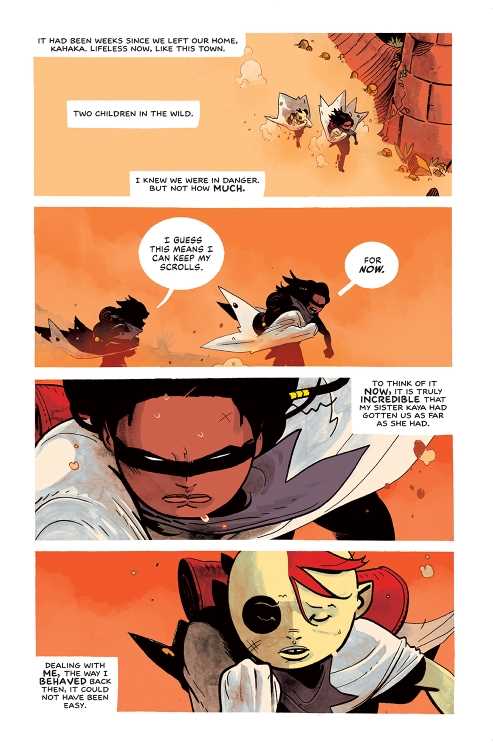 Now, what did make the monthly series was Kaya #6, a never-to-be-collected origin story for Kaya’s magic golden arm that implies the “Golden One” is actually her lonesome self instead of her wee babe bro, Jin. This lights their core dynamic with such dramatic irony that it fundamentally changes what is presented in issues #1-5. But for that, you gotta read Kaya monthly!
Now, what did make the monthly series was Kaya #6, a never-to-be-collected origin story for Kaya’s magic golden arm that implies the “Golden One” is actually her lonesome self instead of her wee babe bro, Jin. This lights their core dynamic with such dramatic irony that it fundamentally changes what is presented in issues #1-5. But for that, you gotta read Kaya monthly!
Sticking sorely to the trade, Kaya reads like a Kamandi-riff on Andrew Maclean’s ApocalyptiGirl or Head Lopper in that Craig clearly wanted to draw a throwback sword-and-sandal adventure, but for today’s sensibilities and light on depth. What rollicks out in chapters 1-3 meets an abrupt, tidy end in chapter 4 where too many cornerstone arcs wrap up as they hit their narrative turns. What doesn’t help is chapter 5 starts new feuds to cliffhanger the trade on, but feels seemingly out of nowhere. This cast of last humans and lizard folk are easily offended, emotionally fragile young adults making their way through it; they even come with an “I didn’t tell you I’m betrothed” romance if that’s your OTP.
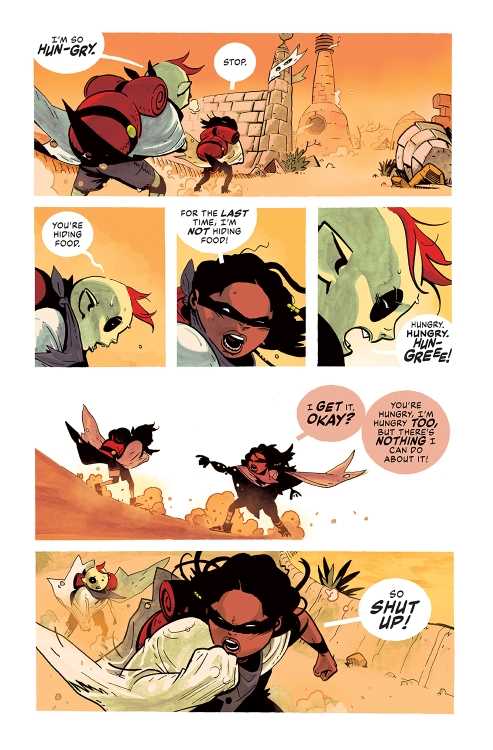
Kaya, an indigenous woman, does suffer from an unfortunate trope as being the last of her kind from a razed village, the guilt of which weighs upon her gas pedal, and starts to feel like “honor” for my fellow AAPI characters. It’s unfortunate that’s her current trajectory since she consistently features a nice portrayal of dreads with Craig utilizing a dry brush and opaque black ink to contour Kaya’s silhouette and reflect her emotional state where possible.
Much like the diversified lizard folk populating the series, Wes Craig fans will be familiar with the mixed use of heavily silhouetted characters against watercolor backdrops. Comfortably, colorist Jason Wordie brings a vivid, though washed approach to Kaya’s lush visuals. Opting for seasonal moods and time of day to dictate page palettes, Wordie’s decisions look stunning atop Craig’s stipple-heavy fantasy realm.
Equally worth praise is letterer Tom Napolitano using balloon tails to add tone to Kaya’s cast. Sometimes the font can feel too big for its balloons, but when Kaya’s balloons have a rectangular end to address her curt mannerisms it rarely causes a kerfuffle. Even more, the lizard riders have a wisp of a balloon tail, which is cute. Another galaxy brain maneuver is dropping the word balloon outline, which lightens the composition of each page to balance out with the stark black Craig employs.
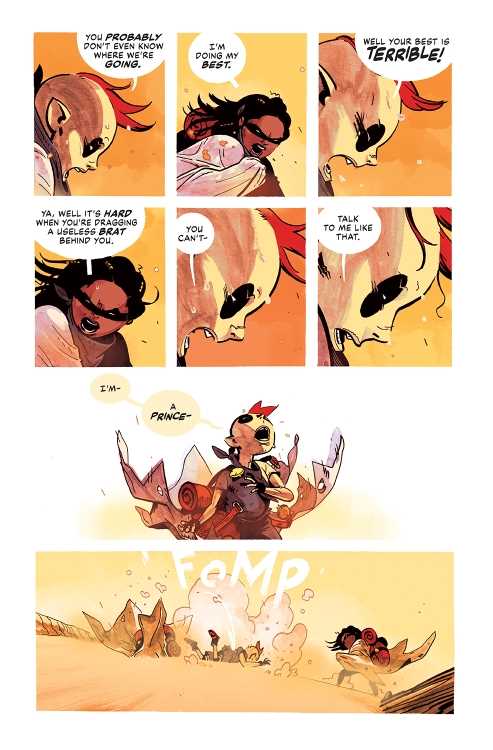
All in all, Kaya feels like Craig traded his mind-bending layouts from Deadly Class for mind-bending compositions and a quick reading flow to ease readers into the adventure. The trade may feel like a stripped down showing of Kaya, but it’s more like a refreshing breeze. If you want the commentary track on this one or Wes Craig’s love (he said “don’t tell the trade-waiters I said this, but I love you (monthly readers) the most.”), then check out Kaya monthly! If not or in the mood for a sword-and-sandal speedrun, check out Kaya in trade!
SPOILER: Kaya only punches with the big Kirby krackle arm four (4) times and never once do we see contact made. If you’re a meathead like me, or that’s what piqued your interest, I’m sorry to report these investigative findings.
Read more trade collection reviews every Thursday in our Trade Rating column!


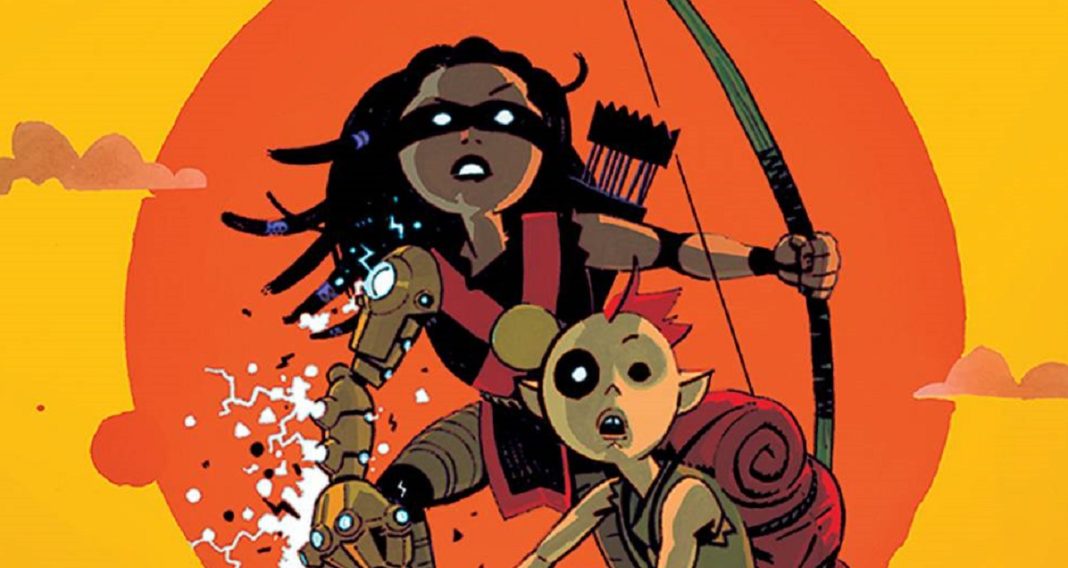
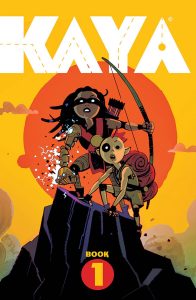

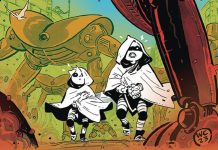
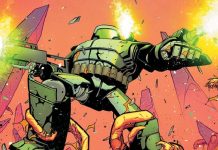


I recently read your review of “Kaya: Book One,” and I must say, I completely agree with your positive assessment of the graphic novel. It’s refreshing to see a new take on the sword and sandal genre, and Kaya’s character is a compelling and dynamic protagonist.
The artwork is beautifully done, and I particularly appreciate how the color palette changes to reflect the mood and setting of each scene. The attention to detail in the world-building is also impressive, and I’m excited to see how the story develops in future volumes.
I also appreciate your analysis of the themes explored in the book, such as the consequences of colonialism and the importance of cultural identity. These are relevant and thought-provoking topics that add depth to the story.
Overall, “Kaya: Book One” is a fantastic graphic novel that is both visually stunning and thematically rich. I highly recommend it to anyone looking for a fresh take on the sword and sandal genre.
Thank you for sharing your insights on this book, and keep up the excellent work in promoting diverse and innovative comics.
Comments are closed.